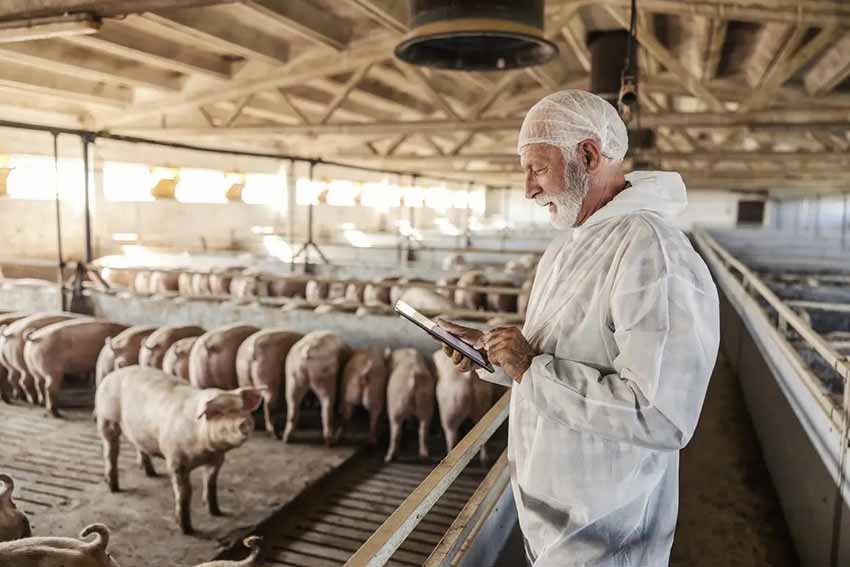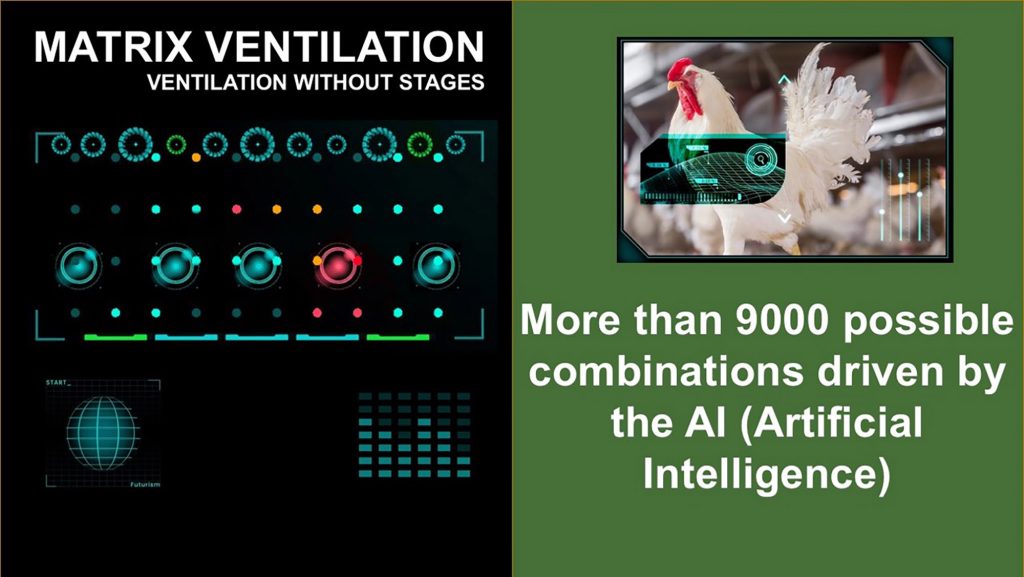Agrimesh Technologies is a precision agriculture company that uses machine learning artificial intelligence and wireless mesh technology to automate and optimize controlled environments in agricultural buildings.
Agrimesh was founded in 2019 by two companies, Penteract and Groupe Jolco. Penteract, the brains behind Agrimesh, is a company that specializes in IoT and artificial intelligence. Groupe Jolco, the business behind Agrimesh, is one of the largest agriculture equipment manufacturers and distributors in Eastern Canada with over 60 years of experience. The owners of both companies, Jean-François Montplaisir and Claude Lévesque, combined their expertise to develop and market an environmental control system that disrupts the conventional way of ventilating and heating livestock buildings.
Easy Engineering: What are the main areas of activity of the company?
AGRIMESH: Agrimesh interconnects the ventilation, heating, feed, and water using wireless mesh technology. It provides considerable installation savings (time and wiring) and ease of installation. The system uses regression algorithms to optimize the environment, improve yields, and reduce energy costs. Using a SMART control system, the environment becomes optimized for ideal farming conditions.
Agrimesh provides a user interface that allows clients to manage their operation onsite and remotely from their smartphone or computer. The system dynamically analyzes inside conditions, outside conditions, and weather forecasts to proactively adjust the ventilation and heating to constantly reach the pre-established setpoints. Each room is controlled and optimized separately. In addition, the system includes a preventative alarm system for high and low temperatures, CO2, water, feed, and maintenance.

E.E: What’s the news about new products?
AGRIMESH: Agrimesh’s success will be based on several metrics, including yield, increase of productivity and profitability, wages, and revenue. Additionally, customers’ will benefit by saved time each day, improved feed conversions, energy optimization (electricity and propane), animal health, improved litter, lower condemn rates, improved grade, and lower installation costs for the system. These metrics will help the company to track their progress towards achieving their goals, including increasing profitability and productivity, improving animal welfare, reducing costs, and enhancing the quality of their products. By using these metrics, Agrimesh will be able to make data-driven decisions and continuously improve their operations, and allow customers to benchmark themselves against their peers.
E.E: What are the ranges of products?
AGRIMESH: emHub is the mastermind behind the Agrimesh system. It is the gateway containing the processor that controls, supervises, and enables devices to interact with each other and makes final decisions based on gathered data. EmHub is like a dedicated computer; in fact, it is the artificial intelligence that manages the entire Agrimesh system.
Because emHub is a modern gateway, it connects to the Internet and gives the owner remote access to the entire system. Even if the Internet is down, the system works locally without interruption. Once the Internet has been restored, emHub will update automatically and the accumulated information will be transferred to the cloud.
Rest easy knowing you have emHub. This powerful minicomputer manages your heating, ventilation, air conditioning, and lighting systems.
The emHub connects to:
- emBreath – temperature and CO2;
- emCO2 – Co2;
- emBreeze – static pressure;
- emFlow – water quantity;
- emDigin – Digital input for Generator ON/OFF and other applications;
- R3 – 3 15 amp relays to turn equipment on/off;
- emActuator – Actuator control;
- emDrive – 0-10V variable speed control.

E.E: At what stage is the market where you are currently active?
AGRIMESH: Agrimesh has strong growth potential as it continues to leverage its dealers and partners, professional network, customer success, online store, events, inbound and outbound marketing. The company’s core values of driving profitability, focusing on sustainability, and relentless innovation will be key drivers of this growth.
E.E: What can you tell us about market trends?
AGRIMESH: The agriculture industry, one of the oldest industries, is facing increasing demand for food at a time when the supply side faces constraints in land and farming inputs. According to McKinsey, the world’s population is expected to reach 9.7 billion by 2050, and by 2030, the water supply will fall 40 percent short of meeting global water needs. Rising energy, labor, and nutrient costs are already putting pressure on profit margins, which makes it essential for the industry to embrace a digital, connectivity-fueled transformation.
In this context, technology can play a crucial role in meeting the challenges facing the agriculture industry. The global poultry market, for instance, is expected to grow at a CAGR of 10.1% from $318.58 billion in 2021 to $350.87 billion in 2022, according to recent market research. The market is projected to reach $493.21 billion in 2026 at a CAGR of 8.9%. According to the USDA, as of 2020, there were 67,500 swine farms in the US, with a total inventory of 77.6 million head. The top swine-producing states were Iowa, Minnesota, and North Carolina. The US swine industry contributes over $23 billion to the US economy annually. As for the dairy industry, there were approximately 31,000 licensed dairy farms in the US in 2020, according to the USDA. These farms had a total inventory of 9.37 million cows. The top dairy-producing states were California, Wisconsin, and New York. The US dairy industry is responsible for producing 220 billion pounds of milk annually, with a value of over $40 billion.
To remain competitive, agriculture businesses must leverage technology to optimize operations, increase productivity, and minimize resource usage. This can include implementing precision agriculture techniques, adopting digital supply chain and logistics solutions, and leveraging big data and analytics to improve decision-making. By embracing a digital transformation, agriculture businesses can ensure sustainable growth and meet the increasing demand for food in the coming years.

E.E: What are the most innovative products marketed?
AGRIMESH: Agrimesh’s wireless smart control is a unique feature that sets it apart from its competitors, who rely on hardwired stage control systems. While hardwired systems have been the industry standard for many years, they can be cumbersome and expensive to install and maintain, especially in larger operations with complex layouts.
In contrast, Agrimesh’s wireless smart control allows for more flexible and efficient system installation and management. Wireless sensors and controllers can be easily installed and repositioned as needed, without the need for expensive and time-consuming rewiring. This can help reduce installation and maintenance costs, as well as minimize downtime and system disruptions. Agrimesh’s wireless smart control provides real-time monitoring and analytics capabilities that enable users to quickly identify and address issues before they escalate. This can help improve system efficiency, productivity, and animal welfare, as well as reduce waste and operating costs. Unlike the traditional stage programmed controls, Agrimesh is the first of its kind to leverage computational power to monitor and manage the environment dynamically
E.E: What estimations do you have for 2023?
AGRIMESH: In 2022, Agrimesh achieved 80% YoY growth, as well as signed on one of the largest private protein producers in the world as a new customer. In 2023, the company will build out its operations and development teams to further focus on growth with the intentions of 100% YOY top line growth. It has kicked off its FY on March 1st 2023 by signing on another klondike customer.

